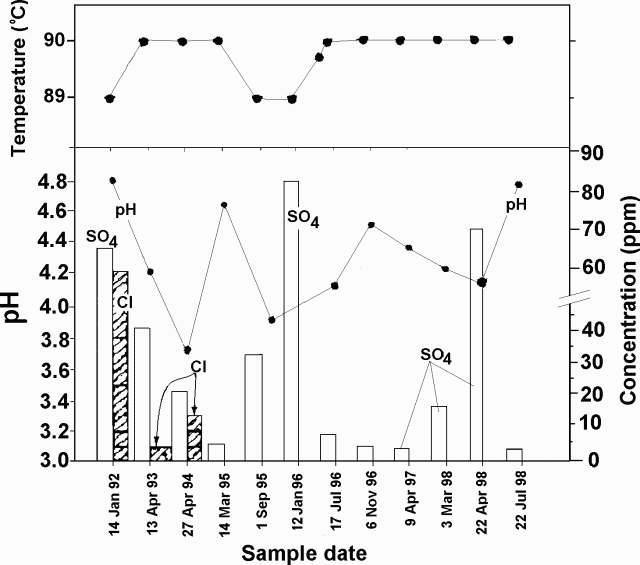Report on Turrialba (Costa Rica) — July 1998
Bulletin of the Global Volcanism Network, vol. 23, no. 7 (July 1998)
Managing Editor: Richard Wunderman.
Turrialba (Costa Rica) Not erupting; seismicity and fumarolic condensate chemistry
Please cite this report as:
Global Volcanism Program, 1998. Report on Turrialba (Costa Rica) (Wunderman, R., ed.). Bulletin of the Global Volcanism Network, 23:7. Smithsonian Institution. https://doi.org/10.5479/si.GVP.BGVN199807-345070
Turrialba
Costa Rica
10.025°N, 83.767°W; summit elev. 3340 m
All times are local (unless otherwise noted)
During July, the main crater continued to weakly emit fumarolic gases with temperatures of 90°C. These escaped along the crater's NE, N, W, and S walls, and small landslides along the crater's N and S walls have partly covered the crater floor. Also, in the central crater, new points appeared on the N side where sulfur-rich gases gently escaped; gas temperatures measured 88°C.
Condensate chemistry and fumarole temperatures taken during 1992 through July 1998 appear on figure 4. Elevated SO4 was measured in condensate sampled on 22 April 1998 (figure 4). This coincided with the appearance of high-frequency earthquakes. Although the SO4 concentration declined in the next condensate sample (22 July), there were 68 high-frequency earthquakes from April through July (table 3).
Table 3. Seismicity registered at Turrialba's seismic station VTU, January-July 1998. Courtesy of OVSICORI-UNA.
| Month | High-frequency | Low-frequency | Microseisms |
| Jan 1998 | 0 | 0 | 53 |
| Feb 1998 | 1 | 1 | 83 |
| Mar 1998 | 3 | 2 | 96 |
| Apr 1998 | 12 | 1 | 28 |
| May 1998 | 15 | 4 | 99 |
| Jun 1998 | 2 | 3 | 60 |
| Jul 1998 | 36 | 4 | 61 |
During 1998 the seismic system (station VTU, 0.5 km NE of the active crater) registered fewer than either 100 microseisms a month or five low-frequency earthquakes a month (table 3). The growth in the number of high-frequency earthquakes was thought to be related to the above-mentioned appearance of the new fumaroles in the central crater. Microseisms were generally weak, with amplitudes below 10 mm.
Geological Summary. Turrialba, the easternmost of Costa Rica's Holocene volcanoes, is a large vegetated basaltic-to-dacitic stratovolcano located across a broad saddle NE of Irazú volcano overlooking the city of Cartago. The massive edifice covers an area of 500 km2. Three well-defined craters occur at the upper SW end of a broad 800 x 2200 m summit depression that is breached to the NE. Most activity originated from the summit vent complex, but two pyroclastic cones are located on the SW flank. Five major explosive eruptions have occurred during the past 3500 years. A series of explosive eruptions during the 19th century were sometimes accompanied by pyroclastic flows. Fumarolic activity continues at the central and SW summit craters.
Information Contacts: E. Fernández, V. Barboza, M. Martinez, E. Duarte, R. Van der Laat, E. Hernández, and T. Marino, Observatorio Vulcanologico y Sismologico de Costa Rica, Universidad Nacional (OVSICORI-UNA), Apartado 86-3000, Heredia, Costa Rica.


